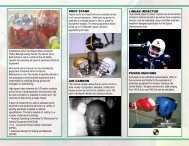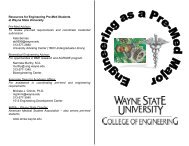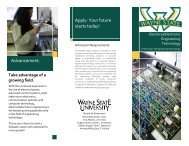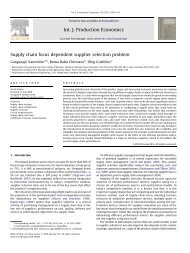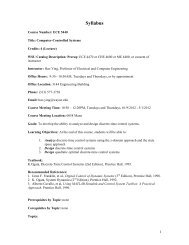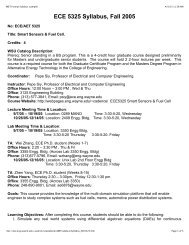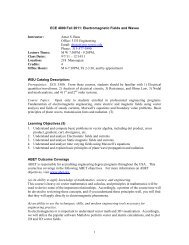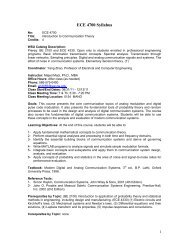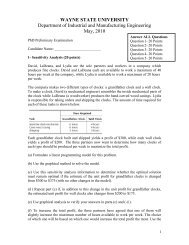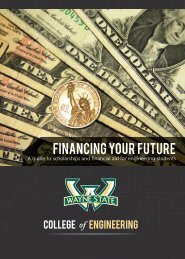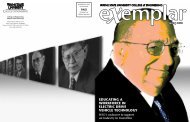ABET Format Syllabus for ECE 5870 - College of Engineering
ABET Format Syllabus for ECE 5870 - College of Engineering
ABET Format Syllabus for ECE 5870 - College of Engineering
Create successful ePaper yourself
Turn your PDF publications into a flip-book with our unique Google optimized e-Paper software.
<strong>ABET</strong> <strong>Format</strong> <strong>Syllabus</strong> (sample)4/9/13 11:37 AM<strong>ECE</strong> 4850 <strong>Syllabus</strong>, Fall 2005No: <strong>ECE</strong> 4850Title: Fiber OpticsCredits: 4 (LCT: 4)WSU Catalog Description:Prereq: <strong>ECE</strong> 3330. Light-wave fundamentals, optical fibers and waveguides, basic optical transmittersand receivers, couplers and switches, basic fiber optic networks, optic link design. (T)Coordinator: Jaewu Choi, Assistant Pr<strong>of</strong>essor <strong>of</strong> Electrical and Computer <strong>Engineering</strong>Instructor: Jaewu Choi, Assistant Pr<strong>of</strong>essor <strong>of</strong> Electrical and Computer <strong>Engineering</strong>Office Hours: Wednesday 10:00 AM –12:00 AMOffice Location: 3133 <strong>Engineering</strong>Phone: 313-577-3990Email: jchoi@ece.eng.wayne.eduCourse Meeting Time: Tuesday & Thursday (5:30 PM - 7:20 PM)Course Meeting Location: 0266 ManoogianGoals: To introduce concepts and fundamentals <strong>of</strong> telecommunications networks based on optical fibertechnology, to develop student’s skill to employ their knowledge to contemporary optical communicationtechnology, and to prepare students <strong>for</strong> more advanced courses in optical fiber communications.Learning Objectives: At the end <strong>of</strong> this course, students will be able to:1. Apply the fundamental principles <strong>of</strong> optics and light wave to design optical fiber communicationsystems.2. Identify structures, functions, materials, and working principle <strong>of</strong> optical fibers, light sources,couplers, detectors, and multiplexers.3. Design optical fiber communication links using appropriate optical fibers, light sources, couplers,detectors, and multiplexers.4. Apply the knowledge developed in-class to contemporary optical fiber communication research andindustrial areasTextbook: Optical Fiber Communications, Gerd Keiser, 3 rd edition, McGraw HillReference Texts: Optics Review (Chapter 2) and Lightwave Fundamentals (Chapter 3), Fiber OpticCommunications, Joseph C. Palais, 3 rd edition, Prentice HallPrerequisites by Topic: (<strong>ECE</strong> 3330) Sinusoidal steady-state concepts. Three-phase systems. Complexfrequency concepts. Frequency response and S-plane. Resonant and coupled circuits. Two-portnetworks.Corequisites by Topic: <strong>ECE</strong> 3330Topics:http://ece.eng.wayne.edu/~patrick/ecewebsite/<strong>ABET</strong>syllabus/<strong>Syllabus</strong>_<strong>ECE</strong>4850.htmPage 1 <strong>of</strong> 6
<strong>ABET</strong> <strong>Format</strong> <strong>Syllabus</strong> (sample)4/9/13 11:37 AM1. Overview <strong>of</strong> Optical Fiber Communications (1/2 week)2. Geometrical optics: (1/2 week)3. Physical Optics (1 week)4. Optical Fibers: Structure, wave guide, material, fiber fabrication (1-1/2 week)5. Signal degradation in optical fibers: Attenuation, signal distortion in optical wave guide, pulsebroadening, mode coupling and design optimization <strong>of</strong> single mode fibers (1-1/2 weeks)6. Optical source: Review on semiconductor physics, Light emitting diodes, laser diodes, light sourcelinearity, modal, partition, and reflection noises, and reliability (2 weeks)7. Power launching and coupling: Source-to-fiber power launching, lensing schemes <strong>for</strong> couplingimprovement, fiber-to-fiber joints, LED coupling to single-mode fibers, fiber splicing, optical fiberconnectors (1 weeks)8. Photodetectors: Physical principle <strong>of</strong> photodetectors, photodetector noise, detector response time,avalanche multiplication noise, structures <strong>for</strong> APDS, temperature effect on avalanche gain,comparison <strong>of</strong> photodetectors (1-1/2 weeks)9. Optical receiver operations: Fundamentals, digital receiver per<strong>for</strong>mance, detailed per<strong>for</strong>mancecalculations, preamplifier types, analog receiver (1 week)10. Wavelength division multiplexing: Operational principles <strong>of</strong> WDM, passive components, tunablesources, tunable filters (2 weeks)Course Structure: The <strong>ECE</strong> 4850 is largely lecture based 4 credit hour course. The class will be held twotimes a week and each class will be two-hour lecture. To encourage students and give them opportunityto drill their learning, three midterms are scheduled and one-final exam is planed. The class notes will beposted on blackboard (http://blackboard.wayne.edu/webapps/portal/frameset.jsp?tab=courses&url=/bin/common/course.pl?course_id=_127589_1).Computer Resources: There will be a series <strong>of</strong> problems assigned using Excel, MathCad, or MatLab.These programs are available on the PCs in the <strong>College</strong>’s PC laboratory, Rooms 2351 and 2359,<strong>Engineering</strong> Building. The PC lab’s hours are posted in front <strong>of</strong> the lab.Laboratory Resources: Not applicableLaboratory Policy: Not applicableDistribution <strong>of</strong> Points: Suggested: Homework (20%), Midterm 1 (10%), Midterm 2 (15 %), Midterm 3(15 %) and Final (40%).The midterm and final exam will be closed book and closed notebooks. The due <strong>of</strong> homework is the firstclass <strong>of</strong> the next week.Grading Scale: 100-95 A; 94-90 A-; 89-85 B+; 84-80 B; 79-75 B-;74-70 C+; 69-65 C; 64-60 C-; Below 60Fail.Attendance: You are expected to attend every class in its entirety. Do not schedule other classes orcommitments that conflict with any part <strong>of</strong> the time during which your class is scheduled. ClassParticipation and attendance will be checked and it will be reflected to the final grade with maximum 5 %<strong>of</strong> the final grade.Schedule:http://ece.eng.wayne.edu/~patrick/ecewebsite/<strong>ABET</strong>syllabus/<strong>Syllabus</strong>_<strong>ECE</strong>4850.htmPage 2 <strong>of</strong> 6
<strong>ABET</strong> <strong>Format</strong> <strong>Syllabus</strong> (sample)4/9/13 11:37 AMSchedule Chapter Topics HWs, TestsWeek 1 TB-Chapter 1(090605)-1Class PolicyOverview <strong>of</strong> Fiber Optical CommunicationsRef #1-Chapter 2 Geometrical Optics-Ray Theory, Total Internal HW1(090805)-2 Reflection, Lens, Imaging, Numerical ApertureWeek 2 Ref #1-Chapter 3(091305)-3Wave Optics- Electromagnetic Waves,Polarization, Reflection at a Plane BoundaryWeek 3Ref#1-Chapter 3(091505)-4(092005)-5TB-Chapter 2(092205)-6Interference, Resonant Cavity, DiffractionOptical Fibers- StructuresHW2Midterm #1Week 4 TB-Chapter 2(092705)-7TB-Chapter 2(092905)-8Week 5 TB-Chapter 3(100405)-9TB-Chapter 3(100605)-10Week 6 TB-Chapter 3(101105)-11TB-Chapter 4(101305)-12Week 7 TB-Chapter 4(101805)-13TB-Chapter 4(102005)-14Week 8 TB-Chapter 4(102505)-15TB-Chapter 5(102705)-16Optical Fibers-WaveguidesOptical Fibers-Fiber Materials and FabricationsSignal Degradation in Optical Fibers-AttenuationSignal Distortion in optical fibersPulse Broadening in Graded-Index WaveguidesDesign Optimization on Single-Mode FibersOptical Sources-Semiconductor PhysicsLight Emission Diode (LED)Laser Diode (LD)-1Laser Diode (LD)-2Power Launching and Coupling-Source to FiberHW3HW4HW5Week 9(110105)-17TB-Chapter 5*Power Launching and Coupling-Midterm #2HW6http://ece.eng.wayne.edu/~patrick/ecewebsite/<strong>ABET</strong>syllabus/<strong>Syllabus</strong>_<strong>ECE</strong>4850.htmPage 3 <strong>of</strong> 6
<strong>ABET</strong> <strong>Format</strong> <strong>Syllabus</strong> (sample)4/9/13 11:37 AMWeek 10 TB-Chapter 6(110805)-19(110305)-18* Source to FiberOptical Receivers (Detectors)-Physical Principles<strong>of</strong> Photodiodes: PIN and APDTB-Chapter 6(111005)-20Week 11 TB-Chapter 6(111505)-21TB-Chapter 7(111705)-22Detector NoisesTemperature effect and Comparison <strong>of</strong> detectors HW 7Optical Receiver Operation-FundamentalReceiver OperationWeek 12 TB-Chapter 7(112205)-23(112405)-24Receiver Per<strong>for</strong>mances/ PreamplifierThanksgivingHW8Week 13(112905)-25TB-Chapter 10*(120105)-26*Wavelength Division Multiplexing 1Midterm #3Week 14 TB-Chapter 10(120605)-27TB-Chapter 10(120805)-28Week15 TB-Chapter 10(121305)-29(121505)-30 Study DayWavelength Division Multiplexing 2Wavelength Division Multiplexing 3Wavelength Division Multiplexing 4-Review <strong>for</strong> Final-Course reviewHW9Week 16 (122005)-31 Final Exam(122205)-32*: The schedule can be affected by business trips <strong>of</strong> the instructor and they will be made-up afterdiscussion <strong>of</strong> the schedule with participants <strong>of</strong> the class.Makeup Exam and Makeup Assignment Policy: In general, no make-up exam and no make-upassignment will be given without any reasonable written notice be<strong>for</strong>ehand.Outcome Coverage:http://ece.eng.wayne.edu/~patrick/ecewebsite/<strong>ABET</strong>syllabus/<strong>Syllabus</strong>_<strong>ECE</strong>4850.htmPage 4 <strong>of</strong> 6
<strong>ABET</strong> <strong>Format</strong> <strong>Syllabus</strong> (sample)4/9/13 11:37 AM(a) an ability to apply knowledge <strong>of</strong> mathematics, science, and engineering: The content <strong>of</strong> the subjects,in-class exercises, and exams require knowledge <strong>of</strong> complex numbers, algebra, geometrics,differential equations, statistics, physics, and communications to successfully complete the course.(b) an ability to design and conduct experiments, as well as to analyze and interpret data: The class willbe implemented with three main approaches <strong>for</strong> efficient knowledge transfer: developing solidunderstanding <strong>of</strong> fundamentals, analyzing main components <strong>of</strong> optical fiber communications, andintegrating each functionality to and design and develop an optical communication link.(c) an ability to design a system, component, or process to meet desired needs within realistic constraintssuch as economic, environmental, social, political, ethical, health and safety, manufacturability, andsustainability: The class will discuss how an efficient communication system has huge economicimpact on society and how it is manufactured.(d) an ability to function on multi-disciplinary teams: The class itself is pretty much multidisciplinary. Itrequires knowledge <strong>of</strong> various disciplines such as mathematics, physics, device physics,communication, manufacturing, and engineering.(e) an ability to identify, <strong>for</strong>mulate, and solve engineering problems: Students will be trained to identify andanalyze problems, convert the problem into mathematical representations or certain <strong>for</strong>mat, and solvethe problem using diverse resources including mathematical s<strong>of</strong>twares and computers.(f) an understanding <strong>of</strong> pr<strong>of</strong>essional and ethical responsibility:(g) an ability to communicate effectively: To develop student’s communication skill, students will beencouraged to participate in both in-class and outside class discussion with the instructor andclassmates.(h) the broad education necessary to understand the impact <strong>of</strong> engineering solutions in a global,economic, environmental, and societal context:(i) a recognition <strong>of</strong> the need <strong>for</strong>, and an ability to engage in life-long learning: To follow up the endlessadvance in technology, the importance <strong>of</strong> life-long education will be emphasized.(j) a knowledge <strong>of</strong> contemporary issues: Students will be trained in contemporary issues in optical fibercommunications. They will be asked to search the advance <strong>of</strong> the technology based recent products inmarket, journals, worldwide websites, and private communications.Cheating Policy and Penalty <strong>for</strong> Cheating: The students should not copy each other’s reports. Duringexamination times no talking and passing papers or other items among the students will be allowed. Theinstructor will give an overall grade <strong>of</strong> F (Fail) to a student if that student is caught with any kind <strong>of</strong>cheating activity. The University defines cheating as “intentionally using or attempting to use, orintentionally providing or attempting to provide, unauthorized materials, in<strong>for</strong>mation, or assistance in anyacademic exercise.” This includes any group ef<strong>for</strong>ts on assignments or exams unless specificallyapproved by the pr<strong>of</strong>essor <strong>for</strong> that assignment/exam. Evidence <strong>of</strong> fabrication or plagiarism, as defined bythe University in its brochure Academic Integrity, will also result in downgrading <strong>for</strong> the course.STUDENTS WHO CHEAT ON ANY ASSIGNMENT OR DURING ANY EXAMINATION WILL BEASSIGNED A FAILING GRADE FOR THE COURSE.There<strong>for</strong>e avoid all appearance <strong>of</strong> improper behavior! Students who witness cheating should report theincident to the instructor as soon as possible.“Academic dishonesty ... tends to compromise the academic integrity <strong>of</strong> the institution or subvert theeducation process. All <strong>for</strong>ms <strong>of</strong> academic dishonesty are prohibited at Wayne State University, asoutlined in the Student Due Process Policy.” -- from Academic Integrity: Important In<strong>for</strong>mation <strong>for</strong> Facultyand StudentsPrepared By: Jaewu Choi, Assistant Pr<strong>of</strong>essor <strong>of</strong> Electrical and Computer <strong>Engineering</strong>http://ece.eng.wayne.edu/~patrick/ecewebsite/<strong>ABET</strong>syllabus/<strong>Syllabus</strong>_<strong>ECE</strong>4850.htmPage 5 <strong>of</strong> 6
<strong>ABET</strong> <strong>Format</strong> <strong>Syllabus</strong> (sample)4/9/13 11:37 AMLast Revised: September 6, 2005http://ece.eng.wayne.edu/~patrick/ecewebsite/<strong>ABET</strong>syllabus/<strong>Syllabus</strong>_<strong>ECE</strong>4850.htmPage 6 <strong>of</strong> 6



